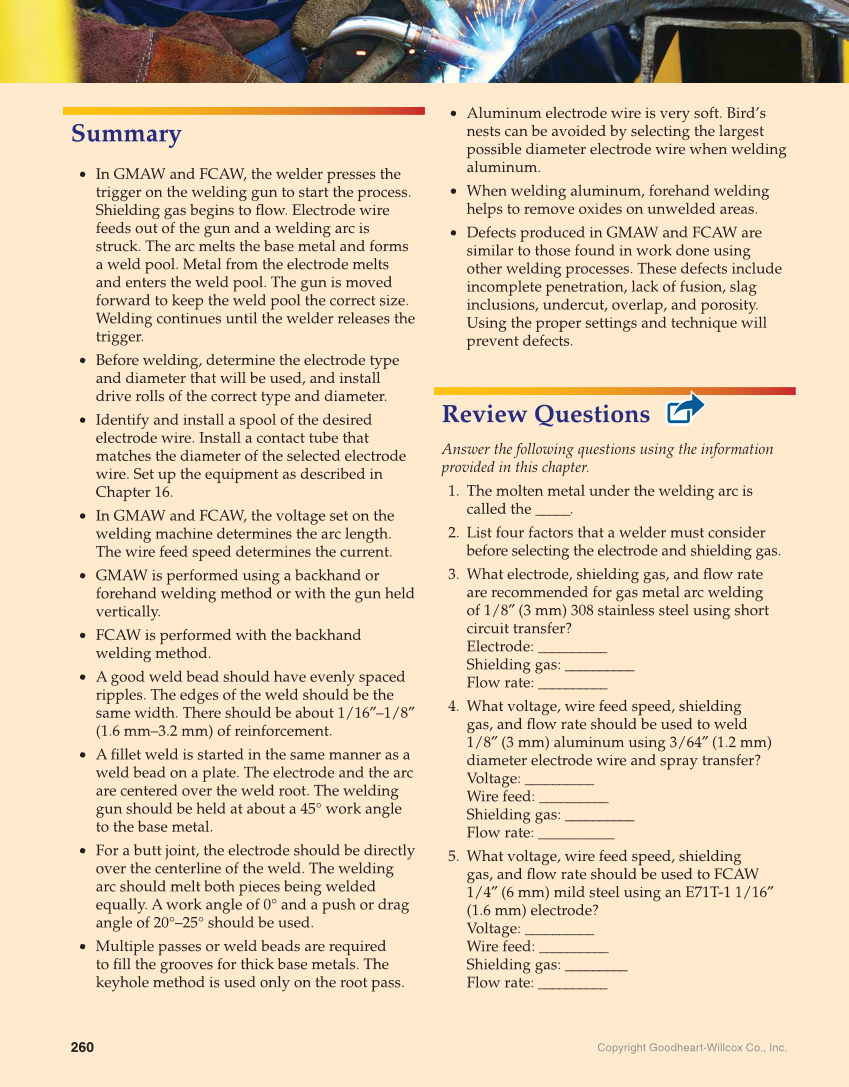Copyright Goodheart-Willcox Co., Inc. 260 Summary • In GMAW and FCAW, the welder presses the trigger on the welding gun to start the process. Shielding gas begins to fl ow. Electrode wire feeds out of the gun and a welding arc is struck. The arc melts the base metal and forms a weld pool. Metal from the electrode melts and enters the weld pool. The gun is moved forward to keep the weld pool the correct size. Welding continues until the welder releases the trigger. • Before welding, determine the electrode type and diameter that will be used, and install drive rolls of the correct type and diameter. • Identify and install a spool of the desired electrode wire. Install a contact tube that matches the diameter of the selected electrode wire. Set up the equipment as described in Chapter 16. • In GMAW and FCAW, the voltage set on the welding machine determines the arc length. The wire feed speed determines the current. • GMAW is performed using a backhand or forehand welding method or with the gun held vertically. • FCAW is performed with the backhand welding method. • A good weld bead should have evenly spaced ripples. The edges of the weld should be the same width. There should be about 1/16″–1/8″ (1.6 mm–3.2 mm) of reinforcement. • A fi llet weld is started in the same manner as a weld bead on a plate. The electrode and the arc are centered over the weld root. The welding gun should be held at about a 45° work angle to the base metal. • For a butt joint, the electrode should be directly over the centerline of the weld. The welding arc should melt both pieces being welded equally. A work angle of 0° and a push or drag angle of 20°–25° should be used. • Multiple passes or weld beads are required to fi ll the grooves for thick base metals. The keyhole method is used only on the root pass. • Aluminum electrode wire is very soft. Bird’s nests can be avoided by selecting the largest possible diameter electrode wire when welding aluminum. • When welding aluminum, forehand welding helps to remove oxides on unwelded areas. • Defects produced in GMAW and FCAW are similar to those found in work done using other welding processes. These defects include incomplete penetration, lack of fusion, slag inclusions, undercut, overlap, and porosity. Using the proper settings and technique will prevent defects. Review Questions Answer the following questions using the information provided in this chapter. 1. The molten metal under the welding arc is called the _____. 2. List four factors that a welder must consider before selecting the electrode and shielding gas. 3. What electrode, shielding gas, and fl ow rate are recommended for gas metal arc welding of 1/8″ (3 mm) 308 stainless steel using short circuit transfer? Electrode: __________ Shielding gas: __________ Flow rate: __________ 4. What voltage, wire feed speed, shielding gas, and fl ow rate should be used to weld 1/8″ (3 mm) aluminum using 3/64″ (1.2 mm) diameter electrode wire and spray transfer? Voltage: __________ Wire feed: __________ Shielding gas: __________ Flow rate: __________ 5. What voltage, wire feed speed, shielding gas, and fl ow rate should be used to FCAW 1/4″ (6 mm) mild steel using an E71T-1 1/16″ (1.6 mm) electrode? Voltage: __________ Wire feed: __________ Shielding gas: _________ Flow rate: __________
